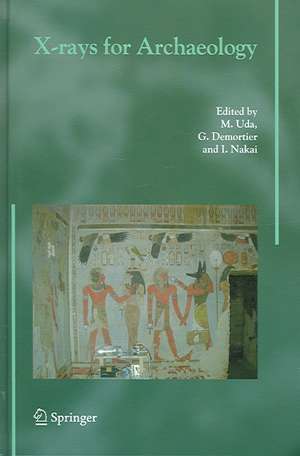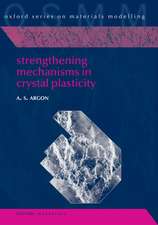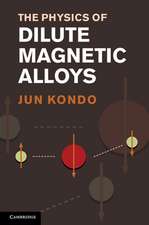X-rays for Archaeology
Editat de M. Uda, G. Demortier, I. Nakaien Limba Engleză Hardback – 10 aug 2005
The book contains scientific data, i.e. in situ measurement data taken with portable XRF and XRD, and fine data taken with accelerating ion beams and synchrotron radiations, and with their explanation. Results obtained by traditional scientific methods are also reviewed. The book contains experimental data taken both from monuments in the field and exhibits in museums, i.e. ancient Egyptian wall painting pigments, ancient Egyptian wooden statues, ancient Egyptian mummies, ancient Greek funerary monuments, Cypriot ceramics, Medieval, Lyubliana and Venetian glass, Romanian ceramics, ancient Near East clay, old Japanese porcelain, pre-Hispanic items from ancient America, ancient Chinese underglaze-red, blue and white porcelain, Chinese celadon, Phoenician cosmetics, glazes, ancient gold and silver coins, gold jewelleries, gold alloys, corroded metals, gemstones (ruby, emerald and garnet), painting pigments, pottery, bronze, obsidian, stucco, turquoise, and so on. This discussion between natural scientists and archaeologists predicts the future direction of archaeology.
| Toate formatele și edițiile | Preț | Express |
|---|---|---|
| Paperback (1) | 945.62 lei 6-8 săpt. | |
| SPRINGER NETHERLANDS – 23 noi 2014 | 945.62 lei 6-8 săpt. | |
| Hardback (1) | 801.14 lei 38-45 zile | |
| SPRINGER NETHERLANDS – 10 aug 2005 | 801.14 lei 38-45 zile |
Preț: 801.14 lei
Preț vechi: 1054.13 lei
-24% Nou
Puncte Express: 1202
Preț estimativ în valută:
153.29€ • 159.67$ • 127.79£
153.29€ • 159.67$ • 127.79£
Carte tipărită la comandă
Livrare economică 24-31 martie
Preluare comenzi: 021 569.72.76
Specificații
ISBN-13: 9781402035807
ISBN-10: 1402035802
Pagini: 308
Ilustrații: IX, 308 p.
Dimensiuni: 210 x 297 x 24 mm
Greutate: 0.7 kg
Ediția:2005
Editura: SPRINGER NETHERLANDS
Colecția Springer
Locul publicării:Dordrecht, Netherlands
ISBN-10: 1402035802
Pagini: 308
Ilustrații: IX, 308 p.
Dimensiuni: 210 x 297 x 24 mm
Greutate: 0.7 kg
Ediția:2005
Editura: SPRINGER NETHERLANDS
Colecția Springer
Locul publicării:Dordrecht, Netherlands
Public țintă
Professional/practitionerCuprins
In-situ Measurements.- Characterization of Pigments Used in Ancient Egypt.- Importance of in-situ EDXRF Measurements in the Preservation and Conservation of Material Culture.- Scientific Field Research in Egypt.- Use of Ion Beam.- Ion Beam Techniques for the Non-destructive Analysis of Archaelogical Materials.- The Origin of Ancient Gemstones Unveiled by PIXE, PIGE and ?-Raman Spectrometry.- Investigations of Medieval Glass by a Combined PIXE/PIGE Method.- PIXE Analysis of Pre-Hispanic Items from Ancient America.- PIXE Study on Chinese Underglaze-Red Porcelain Made in Yuan Dynasty.- Glassmaking in the Venetian Manner.- Studies on Pigments for Ancient Ceramics and Glass Using X-ray Methods.- Compositional Differences of Blue and White Porcelain Analyzed by External Beam PIXE.- Use of Synchroton Radiation.- New Trend in Application of Synchrotron Radiation-Induced X-ray Fluorescence Analysis to Archaeology.- Synchrotron Radiation in Archaeological and Cultural Heritage Science.- Study of the Elemental Distribution in Ancient Chinese Porcelain Using Synchrotron Radiation X-ray Fluorescence.- Study on the Compositional Differences among Different Kilns’ Tang Sancai by SRXRF.- Study of Chemical Composition in Ancient Celadon of Yue Kiln.- Radiography.- The Use of Medical Computed Tomography (CT) Imaging in the Study of Ceramic and Clay Archaeological Artifacts from the Ancient Near East.- The Radiographic Examinations of the “Guardian Statues” from the Tomb of Tutankhamen.- Analytical Study of Paintings by X-ray Radiography and Spectroscopy.- Radiographic Findings in Ancient Egyptian Mummies.- Interdisciplinary Field between Art and Science.- X-ray Application on on Post-Amarna Objects from Dahshur.- Decorative Program at Malqata Palace, Egypt.- X-ray Archaeology inChina.- The Relationship between Arts and Sciences in the Field of Archaeology: from Cooperation to a Truly Equal Partnership.- Color Plates.
Textul de pe ultima copertă
The application of X-rays to archaeological objects with the goal of gaining insight into both their construction and chemical composition, in a non-destructive manner, dates back to the discovery of radiation. Nowadays, X-ray techniques, such as X-ray fluorescense and diffraction are standard tools. This book offers physicists, art historians, archaeologists, curators, and conservators a detailed overview via contributions written by leading scientists in the field. The book contains scientific data, i.e. in situ measurement data taken with portable XRF and XRD, and fine data taken with accelerating ion beams and synchrotron radiations, together with their explanations. Results obtained by traditional scientific methods are also reviewed. The broad data collection spans experimental data taken both from monuments in the field and exhibits in museums, for example:
ancient Egyptian wall-painting pigments
ancient Egyptian wooden statues and mummies
ancient Greek funerary monuments
Cypriot ceramics
medieval, Lyubliana and Venetian glass
Romanian ceramics
ancient Near-Eastern clay
old Japanese porcelain
pre-Hispanic items from America
ancient Chinese underglaze-red
blue and white porcelain
Chinese celadon
Phoenician cosmetics
Also included are data from glazes, ancient gold and silver coins, gold jewelleries, gold alloys, corroded metals, gemstones (ruby, emerald and garnet), painting pigments, pottery, bronze, obsidian, stucco, turquoise, and so on. The discussion fostered here between natural scientists and archaeologists anticipates the future direction of archaeology.
ancient Egyptian wall-painting pigments
ancient Egyptian wooden statues and mummies
ancient Greek funerary monuments
Cypriot ceramics
medieval, Lyubliana and Venetian glass
Romanian ceramics
ancient Near-Eastern clay
old Japanese porcelain
pre-Hispanic items from America
ancient Chinese underglaze-red
blue and white porcelain
Chinese celadon
Phoenician cosmetics
Also included are data from glazes, ancient gold and silver coins, gold jewelleries, gold alloys, corroded metals, gemstones (ruby, emerald and garnet), painting pigments, pottery, bronze, obsidian, stucco, turquoise, and so on. The discussion fostered here between natural scientists and archaeologists anticipates the future direction of archaeology.
Caracteristici
An up-to-date reference on the use of x-rays in archaeology by leading scientists in the field Contains 70 black and white and 10 colour photographs Where the natural sciences and archaeology meet Includes supplementary material: sn.pub/extras















